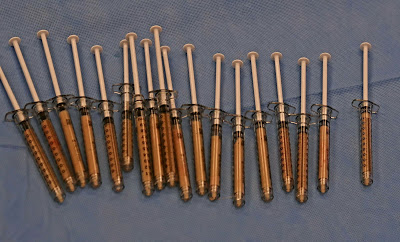Micro fat transfer offers a real alternative for facial rejuvenation without the need for any invasive surgery, and it’s suitable for both men and women.
What is micro fat transfer?
Micro fat transfer is the process of grafting fat to the face using a micro injection technique. This approach allows small droplets of fat to be placed with extreme precision. The fat is carefully layered to restore volume in areas where it has been lost.
Grafting the fat in small quantities allows the surgeon to contour the face like an artist shaping clay. Fat can be placed exactly to plump out lines and wrinkles, and added bit by bit in delicate areas such as under the eye. Not only does this provide a better aesthetic result, but it also maximises the odds that the transplanted fat will gain a blood supply and become permanent tissue.
Is micro fat transfer different to facial fillers?
With micro fat transfer, the fat is added very precisely, drop by drop, requiring a high level of skill. Volume is slowly built up until an optimal level is achieved, avoiding an “over-filled” look and a completely natural looking result.
In addition to this the material being used as a filler - your own body fat - is completely natural. It behaves naturally, with the correct texture and movement and avoids adding anything foreign or synthetic to your body; it’s simply a case of restoring fat to the areas where it used to be.
Another major benefit to using transplanted fat over cosmetic fillers is that it’s a permanent solution. Whereas fillers are reabsorbed by the body and need to be repeated every 9-18 months, transplanted fat remains. It only diminishes with the natural ageing process.

Am I a good candidate for micro fat transfer?
Volume loss is one of the earliest signs of ageing, usually beginning in our thirties. As this loss of volume continues, the face becomes thinner and the skin starts to loosen and sag. Imagine removing stuffing from a cushion; as the volume inside the cushion decreases, the fabric becomes lax and starts to wrinkle.
The fat pads in our face are just like cushions and give us that soft, youthful fullness. The loss of these fat pads is the main reason we start to look older. It’s something we’ve only come to understand quite recently - and it means that we can start fending off the signs of ageing earlier than before.
Previously, a person might have waited until they had significant skin laxity, say in their sixties, to tackle the problem. A full facelift would be performed to tighten the skin, easing the appearance of wrinkling but nothing would be done to restore lost volume. Hence, the facelifts of yesteryear often looked somewhat unnatural.
Now, the plastic surgeon is able to assess a patient’s face to see where volume loss has occurred - and the knock-on effect that’s having. As soon as volume loss begins to occur, it can be “topped up” with fat taken from elsewhere on the body. This makes it a suitable treatment for younger people.
With that said, even more advanced volume loss can be treated with fat grafting. Older patients who don’t want a facelift can still see significant improvements when treated with transplanted fat alone. Meanwhile, older patients who combine surgical skin lifting with micro fat transfer can see incredible results. At Ocean Clinic, all our facelifts also include fat grafting.

What areas can be treated with micro fat transfer?
Most commonly, fat loss starts in the cheeks and temples and this is when gravity begins to take effect, pulling everything else downwards. Restoring fat to these regions can help to pull the lower face back up into place. Fat can also be used to treat:
- Thinning lips
- “Smokers’ lines” around the lips
- Nasolabial folds or “marionette lines”
- Hollows under the eye
- Lack of definition around the jawline
When done throughout the entire face, it can restore a youthful roundness and make a person look younger, healthier and more energetic.
How is micro fat transfer carried out?
The procedure is most commonly performed under local anaesthesia with light sedation. This means you don’t need to stay overnight in the clinic and eliminates the risk of general anaesthesia, which is often a concern for older patients.
A gentle liposuction technique is used to remove the fat from the donor site, which would usually be somewhere we typically store fat, like the tummy, “love handles” or “muffin tops”. To prepare the fat for transfer, we use a centrifuge, separating the fat from the oil, water and blood.
The fat is placed into multiple syringes and then injected in the desired portion of the face. It’s built up layer by layer, until the perfect plumpness is achieved. Other than a very small incision at the fat harvesting site, no incisions are made in the face.

How long is the recovery from micro fat transfer?
Patients who have had micro fat transfer can go home the same day with little discomfort and essentially no downtime. You’re usually able to return to work the following day, although we recommend taking some time off if you can as you may experience some bruising and swelling around the injection sites.
Likewise, you’ll have some tenderness around the donor area and will need to wear compression bandages. Patients usually return to normal activity within a week to 10 days and the final result is seen a month after the treatment.
Want a facial assessment with a surgeon to see what micro fat transfer could do for you? Contact Ocean Clinic for an appointment.

